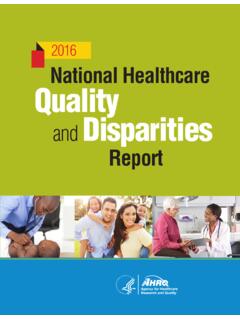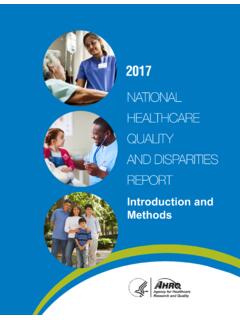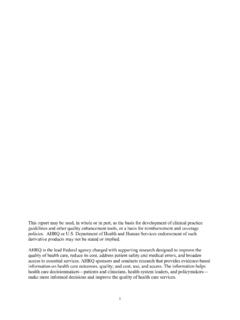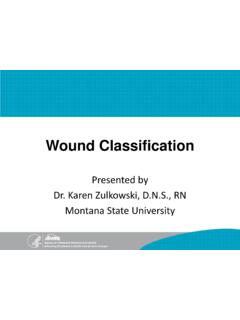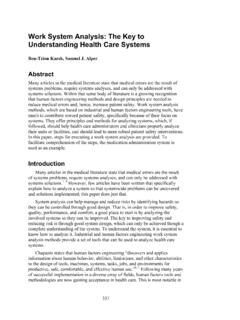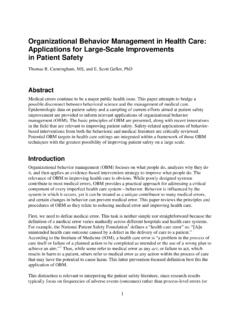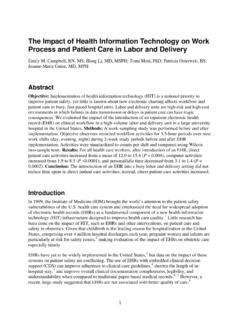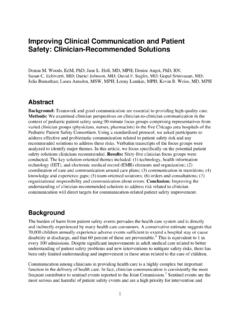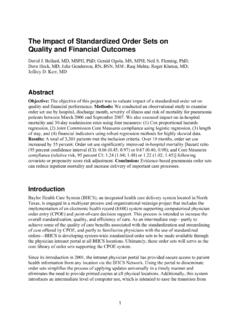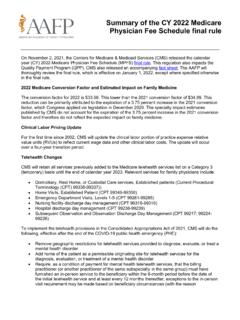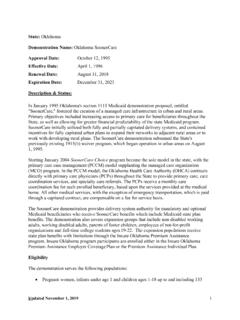Transcription of 2017 National Healthcare Quality and Disparities Report ...
1 B2015 National Healthcare Quality and Disparities Report and National Quality Stategy 5th Anniversary Update2017 National Healthcare QUALITYAND Disparities REPORTData Sources Contents Agency for Healthcare Research and Quality (AHRQ) .. 1 Healthcare Cost and Utilization Project (HCUP) .. 1 National Consumer Assessment of Healthcare Providers and Systems (CAHPS) Benchmarking Database .. 5 Centers for Disease Control and Prevention (CDC) .. 7 Behavioral Risk Factor Surveillance System (BRFSS) .. 7 National HIV/AIDS Surveillance System .. 9 National Ambulatory Medical care Survey (NAMCS) .. 11 National Hospital Ambulatory Medical care Survey (NHAMCS) .. 13 National health and Nutrition Examination Survey (NHANES) .. 14 National health Interview Survey (NHIS).
2 16 National Immunization Survey (NIS) and NIS-Teen .. 20 National Program of Cancer Registries (NPCR) .. 21 National Tuberculosis Surveillance System (NTBSS) .. 23 National Vital Statistics System: Linked Birth and Infant Death Data (NVSS-I) .. 24 National Vital Statistics System: Mortality (NVSS-M) .. 26 National Vital Statistics System: Natality (NVSS-N) .. 29 Centers for Medicare & Medicaid Services (CMS) .. 31 Home health care CAHPS Survey .. 31 CAHPS Hospice Survey .. 33 Hospital CAHPS Survey .. 35 Medicare Quality Improvement Organization (QIO) Program - Clinical Data Warehouse (CDW) .. 37 health Resources and Services Administration (HRSA).. 39 HRSA, Ryan White HIV/AIDS Program (RWHAP) .. 39 Indian health Service (IHS).
3 40 Indian health Service (IHS) National Data Warehouse (NDW) .. 40 National Institutes of health (NIH) .. 42 United States Renal Data System (USRDS) .. 42 Substance Abuse and Mental health Services Administration (SAMHSA) .. 43 National Survey on Drug Use and health (NSDUH) .. 43 Substance Abuse Treatment Episode Data Set (TEDS) .. 46 United States Census Bureau .. 47 American Community Survey (ACS) .. 47 Academic Institutions .. 49 University of Michigan Kidney Epidemiology and Cost Center (UM-KECC) .. 49 Professional Organizations and Associations .. 51 American Hospital Association (AHA) Information Technology (IT) Supplement .. 51 National Cancer Data Base (NCDB) .. 52 Medical Expenditure Panel Survey (MEPS) .. 54 Medicare Patient Safety Monitoring System (MPSMS).
4 57 2017 National Healthcare Quality and Disparities Report Data Sources | 1 Agency for Healthcare Research and Quality (AHRQ) Healthcare Cost and Utilization Project (HCUP) Sponsor Department of health and Human Services, Agency for Healthcare Research and Quality (AHRQ). Description HCUP databases bring together the data collection efforts of State government data organizations, hospital associations, private data organizations, and the Federal Government to create a National information resource of discharge-level health care data. HCUP includes a collection of longitudinal hospital care data, with all-payer, discharge-level information beginning in 1988. Four HCUP discharge datasets were used in this Report : 1. The HCUP Statewide Inpatient Databases (SID) includes discharges for most, if not all, hospitals from 47 States and the District of Columbia.
5 In aggregate, the SID represents almost 97% of all community hospital discharges. The SID contains a core set of clinical and nonclinical information on all patients, regardless of payer. In addition to the core set of uniform data elements common to all of the SID, some States Report other data elements, such as patient race. 2. Prior to data year 2012, the Nationwide Inpatient Sample (NIS) was a stratified sample of hospitals, drawn from the subset of hospitals in the SID that could be matched to the American Hospital Association (AHA) Annual Survey. Hospitals were stratified by region, location/teaching status (within region), bed size category (within region and location/teaching status), and ownership (within region, location/teaching, and bed size categories).
6 Weights were used to develop National estimates. More than 8 million discharges from more than 1,000 hospitals located in 46 States were represented in the 2011 NIS, approximating a 20% stratified sample of community hospitals. In 2012, the NIS was redesigned into a sample of discharges (instead of hospitals). For consistent estimates before and after data year 2012, a nationally weighted analysis file was constructed from the SID using a design consistent with the 2011 NIS, but with a 40 percent sampling rate. 3. The Nationwide Emergency Department Sample (NEDS) was constructed using the HCUP State Emergency Department Databases (SEDD) and the SID. The SEDD captures discharge information on emergency department (ED) visits that do not result in an admission ( , treat-and-release visits and transfers to another hospital).
7 The SID contains information on patients initially seen in the ED and then admitted to the same hospital. The NEDS is a stratified sample of 20% of hospital-based EDs. Thirty-four States and the District of Columbia contributed data to the 2015 NEDS: AR, AZ, CA, CT, DC, FL, GA, HI, IA, IL, IN, KS, KY, MA, MD, ME, MN, MO, MT, NC, ND, NE, NJ, NV, NY, OH, RI, SC, SD, TN, TX, UT, VT, WI, and WI. 4. A nationally weighted analysis file was created from SID each data year for two reasons. First, the availability of information on patient race/ethnicity varied across States and 2 | 2017 National Healthcare Quality and Disparities Report Data Sources hospitals within States. Second, the 20% sample of the hospitals in the NIS did not provide enough statistical power to detect differences in QI estimates between Whites and the other specific racial groups.
8 In 2015, the file consists of weighted records from a sample of hospitals that have high- Quality race/ethnicity data in the following SID: AR, AZ, CA, CO, CT, FL, GA, HI, IA, IL, IN, KS, KY, MA, MD, MI, MO, MS, NC, NJ, NM, NV, NY, OH, OK, OR, PA, RI, SC, SD, TN, TX, UT, VA, VT, WA, WI, and WY in 2012. These 38 States accounted for 91% of hospital discharges (based on the AHA annual survey). The HCUP databases combine race/ethnicity categories, resulting in the following subgroups: Hispanic of all races, and non-Hispanic African Americans, Asians and Pacific Islanders, and Whites. Not all States uniformly collect race and ethnicity data; when a State and its hospitals collect Hispanic ethnicity separately from race, HCUP uses Hispanic ethnicity to override any other race category.
9 Community, nonrehabilitation hospitals from the SID were sampled to approximate a 40% stratified sample of community hospitals, with stratification based on five hospital characteristics: geographic region, hospital ownership, urbanized location, teaching status, and bed size. Hospitals were excluded from the sampling frame if the coding of patient race was suspect. Once the 40% sample was drawn, discharge-level weights were developed to produce National -level estimates when applied to the nationally weighted analysis file. The 2015 final SID Disparities file included about 15 million hospital discharges from more than 2,000 hospitals. Primary Content The HCUP NIS and SID contain more than 100 clinical and nonclinical data variables, including age, gender, race, ethnicity, length of stay, discharge status, source of payment, total charges, hospital size, ownership, region, teaching status, diagnoses, and procedures.
10 The QDR measures that use HCUP data are based on Version of the AHRQ Quality Indicators (QIs), a set of algorithms that may be applied to hospital administrative data to quantify Quality issues among inpatient populations. The QIs fall into four categories: 1. Inpatient Quality Indicators (IQIs) reflect Quality of care in hospitals and currently include 15 mortality indicators for conditions or procedures. The IQIs include indicators for 11 procedures for which utilization varies across hospitals or geographic areas and indicators for 6 procedures for which outcomes may relate to the volume of procedures. 2. Prevention Quality Indicators (PQIs) assess hospital admissions for 14 ambulatory care -sensitive conditions that evidence suggests may be avoided, in part, through high- Quality ambulatory care .
